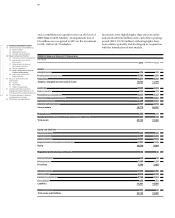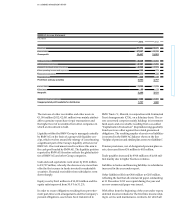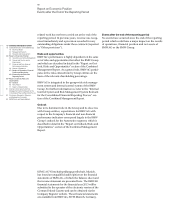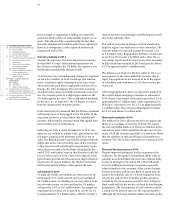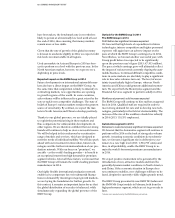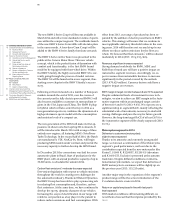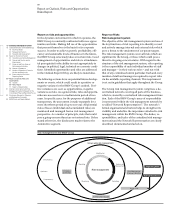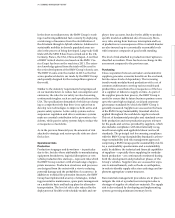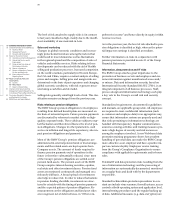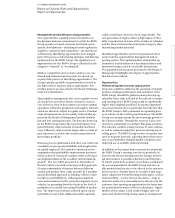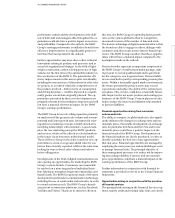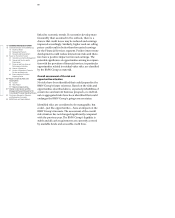BMW 2013 Annual Report Download - page 70
Download and view the complete annual report
Please find page 70 of the 2013 BMW annual report below. You can navigate through the pages in the report by either clicking on the pages listed below, or by using the keyword search tool below to find specific information within the annual report.
70
18 COMBINED MANAGEMENT REPORT
18
General Information on the BMW Group
18 Business Model
20 Management System
23 Research and Development
24 Report on Economic Position
24 Overall Assessment by Management
24 General and Sector-specific
Environment
27
Financial and Non-financial
Performance Indicators
29 Review of Operations
47 Results of Operations, Financial
Position and Net Assets
62 Events after the End of the
Reporting Period
63 Report on Outlook, Risks and
Opportunities
63 Outlook
68 Risks Report
77 Report on Opportunities
81 Internal Control System and Risk
Management System Relevant for
the
Consolidated Financial Reporting Process
82 Disclosures Relevant for Takeovers
and Explanatory Comments
85
BMW Stock and Capital Markets
ditions
continue to exert an unsettling influence over
both markets and consumers. Further risks arise from
other potential economic developments, in particular
a slowdown of economic momentum in China, one of
the BMW Group’s principal markets, which could in turn
result in lower demand for the products and services the
Group offers. As in the previous year, the risk amounts
attached to such an outcome are classified as high.
Any escalation of political conflicts and terrorist ac-
tivities, natural disasters or possible pandemics could
have a negative impact on the world economy and inter-
national capital markets in general. The BMW Group
counters these risks primarily by internationalising
its sales and production structures in order to reduce
the potential impact of risk exposures in individual
countries. The risk amounts attached to these risks are
classified as low.
Overall, as in the previous year, the risk amounts
at-
tached to political and global economic risks are still
classified as high.
Strategic and sector-specific risks
Innovation is the driving force behind the BMW Group’s
success. The primary source of innovation is a
world-
wide global
research and innovation network, in which
employees work closely with one another to find
to-
day’s solutions for tomorrow’s mobility issues. At the
same time, the technical challenges involved in reduc-
ing fuel consumption and emission, are constantly on
the rise. These requirements are accompanied by a
whole swathe of rules that govern individual mobility in
metropolitan areas.
New regulations and rising fuel and energy prices also
exert an influence on customer behaviour. One
sig-
nificant risk for the car industry is the possibility that
laws and regulations could be tightened at short notice,
thus triggering the need for significantly higher levels
of investment. In some cases, changes in customer
be-
haviour are not only brought on by new regulations, but
also through changes of opinion, values and environmen-
tal issues. Among other factors, global climate change
is having an effect on legislation, regulations and con-
sumer behaviour. In order to meet structural changes
in
the demand for individual mobility that no longer
necessarily
means actually owning a vehicle, the BMW
Group is offering corresponding mobility services, such
as the DriveNow car sharing model.
With its Efficient Dynamics concept, the BMW Group is
playing a pioneering role in the premium segment in
reducing both fuel consumption and emissions. With
effect from 2013, our range of products was expanded
by the addition of electric powertrains in BMW i series
vehicles. This strategy will also enable us to fulfil legal
rules and requirements at the same time. The BMW
Group is investing in the development of sustainable
drive technologies and materials, with the aim of pro-
viding
highly efficient vehicles for individual mobility in
the premium segment, both now and in the future.
The BMW Group is also committed to developing
com-
prehensive recycling concepts aimed at recycling mate-
rials as efficiently as possible, closing material loops and
conserving precious resources to the greatest possible
extent. Statutory risks stemming from vehicle recycling
are minimised by means of a specialised in-house team
working in conjunction with regional managers.
Medium- and long-term targets have already been put
in
place in Europe, North America, Japan, China and
other countries to minimise fuel consumption and CO2
emissions. Europe has set a target of achieving an aver-
age of 130 g CO2 / km for all new vehicles by 2015. EU
regulations set targets for CO2 emissions based on
ve-
hicle weight. For the BMW Group this means a target
of
under 140 g CO2 / km per vehicle. The average for
new car fleets in Europe has been set for 2020 at 95 g
CO2 / km. Fuel economy targets have now been fixed in
the USA up to the year 2025. Beginning with a gradual
reduction for 2012 models, the new car fleets of all manu-
facturers
are required to achieve an average emission
value of 250 g CO2 / mile (155 g CO2 / km) by model year
2016 and by 2025 an average value of 163 g CO2 / mile
(101 g CO
2
/ km). Japan has also announced ambitious
targets for reducing fuel consumption. The regulations
for in dividual vehicles and fleets have been implemented
jointly in China. The debate on the successor regulation
has already begun.
The broader market introduction of alternative drive
systems presents new challenges and means additional
investment for the automotive industry. At the same
time the BMW Group also sees the changing situation
as an ideal opportunity to put its technological expertise
and innovative strengths to good use. Greater fuel
economy and the reduction of emissions are fundamen-
tal parameters that are automatically integrated in the
design of new products.


